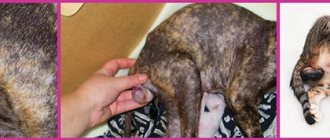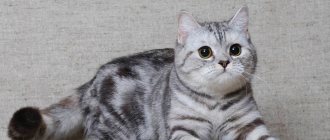British newborns, what they look like, photos
Outdoor cats choose dark, warm places to give birth, usually basements and attics. At home, you need to provide a “birther” for the British woman. It can be made from a large box, 60x60 cm in size, 40 - 50 cm high. Store banana boxes and exhibition tents are suitable. Lay out a diaper for animals and a heating pad.
Depending on the number of kittens in the cat’s womb, a newborn kitten can have a body length of 8 - 12 cm, the weight of kittens is from 70 - 120 g, there are small ones of 50 - 60 g, this happens when there is a multiple pregnancy. Weight table here.
The British are born blind, deaf, with large claws, without undercoat, the fur is not able to warm the baby, so you need to monitor the temperature of the “birthing place” ≈ 38 - 39 C⁰. At the age when kittens sleep 95% of the time, their innate sense of smell and touch allows them to find the cat's nursing nipple. The British mother licks the kittens; without her, they are unable to defecate. In the period from birth to 2 - 3 weeks, you should monitor the daily weight gain of babies by 10 - 20 grams, they should be weighed in the morning at the same time. If someone does not finish eating, then put it on the nipple more often.
Photo – British kittens 3 days old
Stages of development of a newborn British baby by day:
- Days 1 – 3 – baby sleeps, eats;
- 3 – 6 days – the umbilical cord heals, becomes black, dries out, and falls off;
6 days per photo
the picture shows that some already have an umbilical cord missing
- 4 – 7 days – hearing is formed, there is a reaction to loud sounds. The British are all straight-eared!
Plush kittens at 1 week
During this period, babies begin to crawl more actively, and many begin to open their eyes. Children's undercoat is formed and they react more actively to sounds.
British 7 days | 1 Week
It's time to increase the area for cats and choose a name.
British kittens in a playpen
Video of the British in 10 days below.
Little kitties 2 weeks old
British Shorthairs grow quickly, their weight has tripled since birth. They began to sleep less, eat less often, but the portions became larger. They begin to walk unsteadily, with long claws allowing them to maintain balance. By the end of the second week, the eyes open, they will immediately be a little cloudy. The first eye color is blue. They are seen a couple of days after opening on days 14–17. They hear the cat better and respond to its purring.
2 weeks
14 days
British 3 weeks
Kitties see and hear everything, sit and walk confidently, and try to jump. Baby teeth are visible. They are very curious and try to get out of their beds, so it is worth using fences and playpens. The area for children to play should be increased. Provide a scratching post, soft toys, a tray with filler and water.
The cubs actively play with each other, bite and hiss, and practice hunting skills.
2.5 weeks
3 weeks
What to feed a kitten
Four months is a difficult stage for a small animal. This is influenced by stress factors: moving, new surroundings, changing baby teeth, deworming, vaccinations. Against the background of emotional fatigue, the kitten may be malnourished, lose weight, and suffer from digestive disorders.
At this point, the new owner wants to reduce discomfort as much as possible with a variety of foods. However, this is not the right approach. To reduce stress, it is necessary to eliminate irritating factors. Therefore, veterinarians advise starting with establishing the habit of a regular menu.
Before choosing what to feed your kitten, veterinarians advise familiarizing yourself with the different types of diet.
There are only three of them:
- natural products;
- prepared feed;
- mixed diet.
Important! Mixed feeding, that is, the inclusion of natural food in the diet along with ready-made food, is not recommended, as it causes a number of problems with the health of the gastrointestinal tract.
Natural products
By 4 months, kittens' teeth begin to change, so they need solid food rich in protein. The diet of natural products is becoming more varied. The owner is allowed to include new meat ingredients, fermented milk products, more vegetables and cereals.
Feeding natural food is the best option for cats.
It is easier to digest, allows you to introduce new foods into the diet and change it in accordance with the needs of the animal.
Pros:
- saving money. Buying natural products is cheaper than ready-made high-quality food (Premium, Super-premium);
- control. The owner can monitor the amount of vitamins, minerals, calorie content, and nutritional value of the diet, and change them to suit the pet’s needs;
- visibility. When feeding regular food, it is easy to identify the source of a food allergy when specific symptoms are detected.
Minuses:
- waste of time. For a kitten, food is prepared separately; food cannot be given from the human table;
- impossibility of long-term storage. Natural food spoils quickly, so you have to cook it every 1–2 days;
- Preparation. Kittens do not recognize cold food, so it must be warmed before each feeding.
When feeding natural foods, you can go in three ways: give only raw food, feed homemade semi-finished products, or provide a mixed diet of raw and prepared foods.
List of allowed natural food for kittens 4 months:
- boiled low-fat meat - beef, veal, chicken, turkey, rabbit. You can grind it and give it boiled minced meat;
- low-fat fermented milk products – kefir, fermented baked milk, cottage cheese in large quantities (will help strengthen teeth and bone tissue);
- fillet of lean sea fish (without bones, fins, scales) - boiled, chopped;
- finely chopped boiled offal (beef, poultry);
- eggs - raw, boiled, with vegetables, cereals;
- raw or boiled grated vegetables - zucchini, pumpkin, cabbage;
- cereals – cooked in broth (rice is better for kittens);
- grass - you can buy it at a pet store or grow it yourself (oat, wheat sprouts).
If the kitten is growing normally, without delays, then it does not need an additional portion of carbohydrate food. Therefore, you should not exceed the norm of porridge or add it as a filler.
Industrial feed
Currently, many owners are introducing their pets to commercial food. However, not everyone knows how to choose ready-made food correctly.
Pet stores offer three types of industrial food: dry, semi-moist and wet. It is also divided by class. Premium and Super-premium are recommended for kittens, as they are as close as possible in composition, nutritional value and taste to natural food.
Pros:
- balance. Manufacturers took into account the needs of animals, so they included all the necessary nutrients and beneficial substances (amino acids, vitamins, minerals);
- ability for long-term storage. When closed, they are stored for a long time under optimal conditions. For example, wet and semi-moist food - in the refrigerator;
- convenience. The number of servings and dosage are indicated on the package, which eliminates the need to count them each time.
Minuses:
- high cost. It is recommended to feed kittens with high quality food, so ready-made food will cost several times more than natural products;
- uncertainty about quality. Popular brands are often counterfeited, so you need to choose food carefully.
At four months of age, kittens lose their baby teeth, so they should not be fed dry food.
The diet will then consist of wet (pates), semi-moist (in sauce or jelly) feed. Dry granules are allowed to be given only in a soaked form.
As they grow older, the proportion of dry food in the diet gradually increases. To complete the formation of the body, dry granules should account for up to 75%, the rest of the feed - 25%.
Kitten 1 month
The period of appearance of bear-type kittens. Month-old kittens are formed unevenly; a large body on short thick legs reminds us of a small bear. They sleep 16–20 hours, are very active, and play a lot.
4 weeks
Month-old kittens drink water on their own for 4 weeks, many eat wet and dry food themselves, and go to the litter box. Time to work with the kitten and adapt to the hands, teaching manners. The “change of color” of the eyes from blue to orange (for blue color), this happens gradually.
1 month
5 – 6 weeks | After 1.5 months, the kitten licks its fur and washes itself, the undercoat thickens, and the color becomes brighter.
5 weeks
At 7–8 weeks, babies are still drinking their mother’s milk and learning cat wisdom from her. The eyes acquired their color, became bright and clear.
1.5 months
Ready-made feed
There are a huge number of opinions regarding which food is better - ready-made or natural. As for industrial products, the advantages here are obvious - a complete balanced diet and ease of use. The disadvantages include the presence of synthetic food additives in some feeds.
If you have chosen to feed your pet industrial food, you should consider some rules for their use.
- Do not combine dry and wet food in your diet.
- Do not change the brand of the product.
Read the manufacturer's recommendations carefully. Starting from the age of four months, the kitten can give out the entire daily portion of dry food immediately, since kittens by this time are already able to control their appetite. Wet food should be given in portions equal to a single volume and in a heated form.
In order not to harm your pet’s health, it is better to choose proven and reliable manufacturers, such as: NutroChoice, RoyalCanin, Purina, Acana. The product lines of these manufacturers include both dry and wet diets.
Among the most popular brands that produce food for kittens are:
- Canadian brand "Akana". The company's products belong to the super-premium category and represent a complete, balanced diet with a low level of allergenicity. Products are made from whole, fresh raw materials of plant and animal origin. Meat component - at least 70%, the rest - vegetables, seaweed, fruits, cereals, eggs. The recipe is enriched with unsaturated fatty acids, vitamins, and microelements.
- French brand Royal Canin. The optimal content of nutrients necessary for the development and growth of kittens puts the products of this brand on a par with natural nutrition. The manufacturer recommends using the food starting from the age of four months for the kitten. The company's product line also includes a series of veterinary foods recommended for consumption based on a specific disease.
British kitten 2 – 3 months
Kittens feed themselves, go to the toilet, and play. They are very curious and it is worth taking care of their safety: close the windows, remove poisonous plants, dangerous sharp toys, threads, buttons. They suck a cat out of habit; they will do this until they are weaned or the cat stops letting them come to them. The paws of kittens lengthen and no longer resemble bear cubs, all this is due to uneven development. Character begins to emerge. It is worth spending more time raising children, teaching them to use a comb and a scratching post. Two months – it’s worth carrying out the first deworming and getting vaccinated; more about vaccinations here. Three months – repeated vaccination against viral infections and rabies vaccination are carried out. After three months, the kitten is considered socially adapted and can move to a new home.
Kitten 4 months – 1 year
Age 4 months – the number of meals is reduced, growth slows down, activity is high. Baby teeth begin to fall out.
5 months – the skeleton of the animal is formed, the pattern on solid colors practically disappears.
6 months – we see not a kitten, but an almost fully formed Briton. The coat needs weekly brushing. If the animal will not participate in breeding, then it is worth castrating or sterilizing it. 7 months – the male cat reaches sexual maturity. After 8 months, the British are considered adults. You should monitor your pet's diet.
12 months – gradually transfer the cat to adult or sterilized food. Read more about cat nutrition here.
adult blue shorthair at 14 months
Vitamins and supplements
If you decide to feed your pet high-quality food, additional vitamins and supplements are introduced into the diet only if there is growth retardation or on the recommendation of a veterinarian. It is important to understand that an excess of vitamins is no less dangerous than their deficiency.
Advice! With a natural type of nutrition, up to the age of 1 year, vitamins are given on an ongoing basis. When the kitten is one year old, vitamins can be given in courses.
You can add natural sources of vitamins and minerals to your kitten’s food:
- Meat and bone meal.
- Fish, chicken, beef liver.
- Greens, vegetables, fruits.
- Sunflower oil, olive oil.
- Brewer's yeast.
In addition to vitamins, cats urgently need taurine. A rare amino acid is found in:
- Turkey.
- Rabbit.
- Chicken heart and liver.
- Beef heart.
- Pork, after deep freezing.
- Boiled pork liver.
- Ocean fish and shellfish.
- Raw red fish.
- Live homemade yogurt.
- Whole milk.
Pharmaceutical products are also rich sources of vitamins:
- Fish fat.
- Feed tricalcium phosphate.
- Omega-3, Omega-6.
- B vitamins.
You can buy basic vitamin complexes for cats at a pet store or veterinary pharmacy. Drugs are dosed by weight. Vitamin complexes are usually available in the form of tablets that can be crushed and added directly to food.
How to determine the gender of a kitten, boy or girl
The female's genitals consist of the anus and vulva, while the male's genitals consist of the anus, testicles and penis. To determine the sex of a kitten, place it on your palm and raise its tail; if the location of the genitals is similar to “i” - a girl, if “:” - a cat, the distance between their anus and penis is greater than that of cats. Also, in cats from 3 to 4 weeks, the testicles can be felt.
how to determine the gender of a kitten
From the age of 10 months, the British can participate in exhibitions, open class.
You should visit a veterinarian annually and adjust your vaccination schedule. The British breed is fully formed by 2 - 3 years. Reviews from owners indicate that after castration, kittens do not become less active than before. The main thing is the desire to care and play with your pet. [Total: 5 Average: 5/5]











